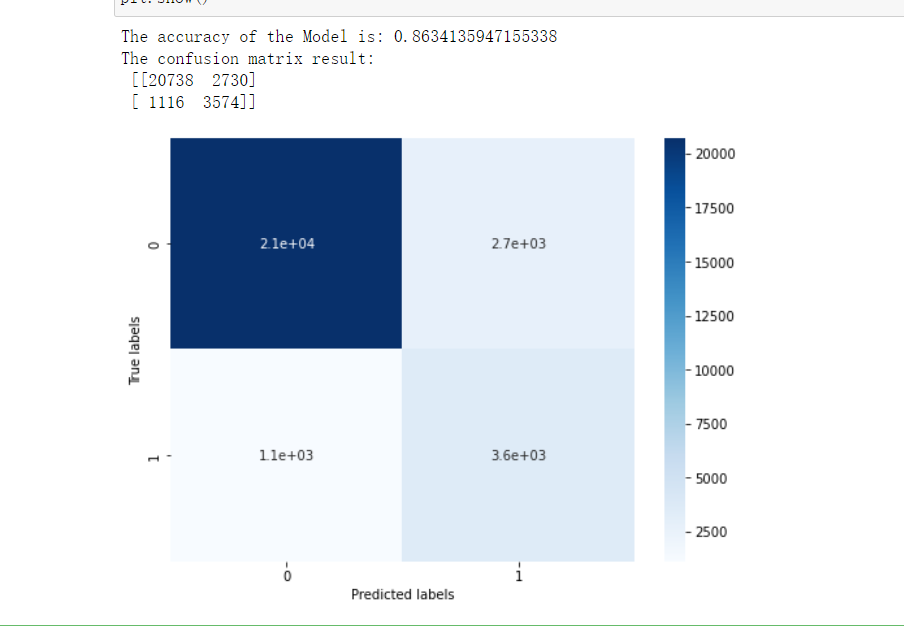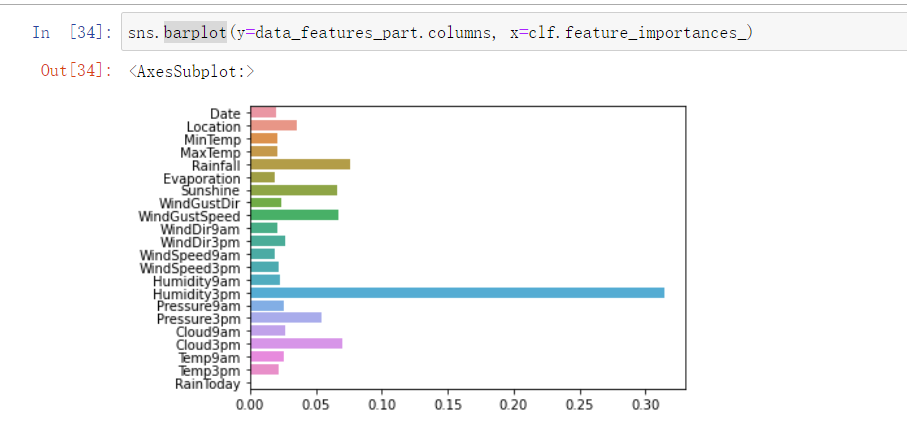澳大利亚天气预测数据分析
一、选题背景
天气预报我们每天都会关注,我们可以根据未来的天气增减衣物、安排出行,每天的气温、风速风向、相对湿度、空气质量等成为关注的焦点。采用公开数据集:澳大利亚多个地点的大约 10 年的每日天气观测数据,对数据集预处理(重复值,缺失值等),借助图形来实现数据可视化,便于更加直观、清晰、有效地展现出来,使得用户可以从不同的维度观察数据,对数据有更深入地理解,在利用机器学习来进一步分析,为获得未来天气信息提供了有效方法。
二、大数据分析设计方案
1.本数据集的数据内容与数据特征分析
|
字段名称 |
字段类型 |
字段说明 |
|
Data |
浮点型 |
观察日期 |
|
location |
浮点型 |
气象站位置的通用名称 |
|
MinTemp |
浮点型 |
以摄氏度为单位的最低温度 |
|
Maxtemp |
浮点型 |
以摄氏度为单位的最高温度 |
|
Rainfall |
浮点型 |
以毫米为单位记录的当天降雨量 |
|
Evaporation |
浮点型 |
所谓A类锅蒸发量(mm)在24小时到早上9点 |
|
Sunshine |
浮点型 |
—天中阳光明媚的小时数 |
|
WindGustDir |
浮点型 |
24小时至午夜最强阵风方向 |
|
WindGustSpeed |
浮点型 |
至午夜24小时内最强阵风的速度(km\/h) |
|
WindDir9am |
浮点型 |
上午9点的风向 |
|
WindDir3pm |
浮点型 |
下午3点的风向 |
|
WindSpeed9am |
浮点型 |
上午9点前10分钟的平均风速(km\/h) |
|
WindSpeed3pm |
浮点型 |
午3点前10分钟的平均风速(km\/h) |
|
Humidity9am |
浮点型 |
上午9点的湿度〔百分比) |
|
Humidity3am |
浮点型 |
下午3点的湿度〔百分比) |
|
Pressure9am |
浮点型 |
大气压(hpa)在上午9点降至平均海平面 |
|
Pressure3pm |
浮点型 |
下午3点大气压力(hpa)降至平均海平面 |
|
Cloud9am |
浮点型 |
上午9点被云遮蔽的天空部分。这是用"oktas"来衡量的,它是一个八分之一。它记录了有多少八分之一的天空被云遮住了。0分表示天空完全晴朗,而8分表示完全阴天。 |
|
Cloud3pm |
浮点型 |
下午3点被云遮蔽的天空部分(在"oktas"中:八分之一)。有关值的说明,请参阅Cload9am |
|
Temp9am |
浮点型 |
上午9点的温度(摄氏度) |
|
Temp3pm |
浮点型 |
下午3点的温度(摄氏度) |
|
RainToday |
浮点型 |
如果24小时内到上午9点的降水量(mm)超过1mm为1,否则为0 |
|
RainTomorrow |
浮点型 |
以毫米为单位的第二天降雨量,用于创建响应变量Rain Tomorrow,一种衡量"风险"的方法。 |
2、数据分析的课程设计方案概述
采用公开的数据集:
/www.kaggle.com/datasets/jsphyg/weather-dataset-rattle-package
数据清洗:导入公开数据,缺失值处理,补充缺失值,对数值特征进处理
数据可视化:箱型图,pairplot、分组条形图、heatmap(热力图)等来对第二天是否下雨进行预测
机器学习:在训练集和测试集上分布利用训练好的模型进行预测,xgboost预测正确率以及特征重要性等处理采集到的数据
三、数据分析的步骤
导入需要的库
import numpy as np import pandas as pd import matplotlib.pyplot as plt import seaborn as sns %matplotlib inline
1、数据清洗
data = pd.read_csv(r'weatherAUS.csv')#导入数据 data.info()

data.dropna(subset = ['RainTomorrow','RainToday'],inplace=True) #缺失值处理(24小时降雨和第二天降雨) data = data.fillna(-1)#缺失数据填充 data.tail()#默认显示数据最后5行

pd.Series(data['RainTomorrow']).value_counts() #value_counts 直接用来计算series里面相同数据出现的频率 data.describe()#查找给定系列对象的摘要统计信息


2、数据可视化分析
category_features data_plot = data[['Rainfall','Evaporation','Sunshine'] + ['RainTomorrow']] data_plot

plt.figure() sns.pairplot(data=data_plot,diag_kind="kde",hue= 'RainTomorrow') plt.show()#在当天降雨量、蒸发量、阳光小时数判断第二天是否下雨

根据图可知,第二天的降水量与当天降雨量、蒸发量、阳光小时数有关,前一天降水少,第二天降水的的概率偏高,日照小时数少也与第二天是否下雨有关,日照少,第二天降水的概率偏高。
for col in data[numerical_features].columns: if col != 'RainTomorrow': sns.boxplot(x='RainTomorrow',y=col,saturation=0.5,palette='pastel',data=data) plt.title(col) plt.show()#箱型图

有图可知,预测第二天是否下雨,与各个因素之间的联系,蒸发、当天降雨,大气压强直接的表示不是很清楚,当天日照越长,第二天不会下雨概率高反之,被云遮住的面积多,第二天下雨比不下雨要略高。

分组条形图:
plt.figure(figsize=(10,10)) plt.subplot(1,2,1) plt.title('RainTomorrow') sns.barplot(x = pd.DataFrame(tlog['Location']).sort_index()['Location'], y = pd.DataFrame(tlog['Location']).sort_index().index, color = "Violet") plt.subplot(1,2,2) plt.title('Not RainTomorrow') sns.barplot(x = pd.DataFrame(flog['Location']).sort_index()['Location'], y = pd.DataFrame(flog['Location']).sort_index().index, color = "Lavender") plt.show()

plt.figure(figsize=(10,2)) plt.subplot(1,2,1) plt.title('RainTomorrow') sns.barplot(x = pd.DataFrame(tlog['RainToday'][:2]).sort_index()['RainToday'], y = pd.DataFrame(tlog['RainToday'][:2]).sort_index().index, color = "Violet") plt.subplot(1,2,2) plt.title('Not RainTomorrow') sns.barplot(x = pd.DataFrame(flog['RainToday'][:2]).sort_index()['RainToday'], y = pd.DataFrame(flog['RainToday'][:2]).sort_index().index, color = "Lavender") plt.show()

3、机器学习
## 把所有的相同类别的特征编码为同一个值 def get_mapfunction(x): mapp = dict(zip(x.unique().tolist(), range(len(x.unique().tolist())))) def mapfunction(y): if y in mapp: return mapp[y] else: return -1 return mapfunction for i in category_features: data[i] = data[i].apply(get_mapfunction(data[i])) data.head() data.loc[:, 'RainTomorrow'] = data.loc[:, 'RainTomorrow'].map({'No': 0, 'Yes': 1}) from sklearn.model_selection import train_test_split data_target_part = data['RainTomorrow'] data_features_part = data[[x for x in data.columns if x!='RainTomorrow']] x_train_val,x_test,y_train_val,y_test = train_test_split(data_features_part,data_target_part,test_size = 0.2, random_state = 42) x_train,x_val,y_train,y_val = train_test_split(x_train_val,y_train_val,test_size = 0.25, random_state = 42) ## 导入XGBoost模型 from xgboost.sklearn import XGBClassifier ## 定义 XGBoost模型 clf = XGBClassifier() # 在训练集上训练XGBoost模型 clf.fit(x_train, y_trai

## 在训练集和测试集上分布利用训练好的模型进行预测 train_predict = clf.predict(x_train) val_predict = clf.predict(x_val) from sklearn import metrics print('The accuracy of the Model is:',metrics.accuracy_score(y_val,val_predict)) confusion_matrix_result = metrics.confusion_matrix(val_predict,y_val) print('The confusion matrix result:\n',confusion_matrix_result) plt.figure(figsize=(8, 6)) sns.heatmap(confusion_matrix_result, annot=True, cmap='Blues') plt.xlabel('Predicted labels') plt.ylabel('True labels') plt.show()


from sklearn.metrics import accuracy_score from xgboost import plot_importance #预测正确率以及特征重要性,重要特征值越大,说明该特征越重要 def estimate(model,data): #sns.barplot(data.columns,model.feature_importances_) ax1=plot_importance(model,importance_type="gain") ax1.set_title('gain') ax2=plot_importance(model, importance_type="weight") ax2.set_title('weight') ax3 = plot_importance(model, importance_type="cover") ax3.set_title('cover') plt.show() def classes(data,label,test): model=XGBClassifier() model.fit(data,label) ans=model.predict(test) estimate(model, data) return ans ans=classes(x_train,y_train,x_val) pre=accuracy_score(y_val, ans) print('acc=',accuracy_score(y_val,ans))

from sklearn.model_selection import GridSearchCV ## 定义参数取值范围 learning_rate = [0.3,0.5,0.7] subsample = [0.8, 0.9] colsample_bytree = [0.7,0.8] max_depth = [7,8,9,10] parameters = { 'learning_rate': learning_rate, 'subsample': subsample, 'colsample_bytree':colsample_bytree, 'max_depth': max_depth} model = XGBClassifier(n_estimators = 50) ## 进行网格搜索 clf = GridSearchCV(model, parameters, cv=3, scoring='accuracy',verbose=1,n_jobs=-1) clf = clf.fit(x_train, y_train)

test_predict = clf.predict(x_test)
print('The accuracy of the Model is:',metrics.accuracy_score(y_test,test_predict))

4、附上完整代码
import numpy as np import pandas as pd import matplotlib.pyplot as plt import seaborn as sns %matplotlib inline data = pd.read_csv(r'weatherAUS.csv')#导入数据 data.info() data.shape data.head() data.dropna(subset = ['RainTomorrow','RainToday'],inplace=True) #缺失值处理(24小时降雨和第二天降雨) data = data.fillna(-1)#缺失数据填充 data.tail()#默认显示数据最后5行 pd.Series(data['RainTomorrow']).value_counts() #value_counts 直接用来计算series里面相同数据出现的频率 data.describe()#查找给定系列对象的摘要统计信息 numerical_features = [x for x in data.columns if data[x].dtype == float] category_features = [x for x in data.columns if data[x].dtype != float and x != 'RainTomorrow'] numerical_features#数值特征处理 category_features data_plot = data[['Rainfall','Evaporation','Sunshine'] + ['RainTomorrow']] data_plot plt.figure() sns.pairplot(data=data_plot,diag_kind="kde",hue= 'RainTomorrow') plt.show()#在当天降雨量、蒸发量、阳光小时数判断第二天是否下雨 for col in data[numerical_features].columns: if col != 'RainTomorrow': sns.boxplot(x='RainTomorrow',y=col,saturation=0.5,palette='pastel',data=data) plt.title(col) plt.show()#箱型图 tlog={} for i in category_features: tlog[i] = data[data['RainTomorrow'] == 'Yes'][i].value_counts() flog={} for i in category_features: flog[i] = data[data['RainTomorrow'] == 'No'][i].value_counts() tlog plt.figure(figsize=(10,10)) plt.subplot(1,2,1) plt.title('RainTomorrow') sns.barplot(x = pd.DataFrame(tlog['Location']).sort_index()['Location'], y = pd.DataFrame(tlog['Location']).sort_index().index, color = "Violet") plt.subplot(1,2,2) plt.title('Not RainTomorrow') sns.barplot(x = pd.DataFrame(flog['Location']).sort_index()['Location'], y = pd.DataFrame(flog['Location']).sort_index().index, color = "Lavender") plt.show() plt.figure(figsize=(10,2)) plt.subplot(1,2,1) plt.title('RainTomorrow') sns.barplot(x = pd.DataFrame(tlog['RainToday'][:2]).sort_index()['RainToday'], y = pd.DataFrame(tlog['RainToday'][:2]).sort_index().index, color = "Violet") plt.subplot(1,2,2) plt.title('Not RainTomorrow') sns.barplot(x = pd.DataFrame(flog['RainToday'][:2]).sort_index()['RainToday'], y = pd.DataFrame(flog['RainToday'][:2]).sort_index().index, color = "Lavender") plt.show() ## 把所有的相同类别的特征编码为同一个值 def get_mapfunction(x): mapp = dict(zip(x.unique().tolist(), range(len(x.unique().tolist())))) def mapfunction(y): if y in mapp: return mapp[y] else: return -1 return mapfunction for i in category_features: data[i] = data[i].apply(get_mapfunction(data[i])) data.head() data.loc[:, 'RainTomorrow'] = data.loc[:, 'RainTomorrow'].map({'No': 0, 'Yes': 1}) from sklearn.model_selection import train_test_split data_target_part = data['RainTomorrow'] data_features_part = data[[x for x in data.columns if x!='RainTomorrow']] x_train_val,x_test,y_train_val,y_test = train_test_split(data_features_part,data_target_part,test_size = 0.2, random_state = 42) x_train,x_val,y_train,y_val = train_test_split(x_train_val,y_train_val,test_size = 0.25, random_state = 42) ## 导入XGBoost模型 from xgboost.sklearn import XGBClassifier ## 定义 XGBoost模型 clf = XGBClassifier() # 在训练集上训练XGBoost模型 clf.fit(x_train, y_train) ## 在训练集和测试集上分布利用训练好的模型进行预测 train_predict = clf.predict(x_train) val_predict = clf.predict(x_val) from sklearn import metrics print('The accuracy of the Model is:',metrics.accuracy_score(y_val,val_predict)) confusion_matrix_result = metrics.confusion_matrix(val_predict,y_val) print('The confusion matrix result:\n',confusion_matrix_result) plt.figure(figsize=(8, 6)) sns.heatmap(confusion_matrix_result, annot=True, cmap='Blues') plt.xlabel('Predicted labels') plt.ylabel('True labels') plt.show() sns.barplot(y=data_features_part.columns, x=clf.feature_importances_) from sklearn.metrics import accuracy_score from xgboost import plot_importance #预测正确率以及特征重要性,重要特征值越大,说明该特征越重要 def estimate(model,data): #sns.barplot(data.columns,model.feature_importances_) ax1=plot_importance(model,importance_type="gain") ax1.set_title('gain') ax2=plot_importance(model, importance_type="weight") ax2.set_title('weight') ax3 = plot_importance(model, importance_type="cover") ax3.set_title('cover') plt.show() def classes(data,label,test): model=XGBClassifier() model.fit(data,label) ans=model.predict(test) estimate(model, data) return ans ans=classes(x_train,y_train,x_val) pre=accuracy_score(y_val, ans) print('acc=',accuracy_score(y_val,ans)) ## 从sklearn库中导入网格调参函数 from sklearn.model_selection import GridSearchCV ## 定义参数取值范围 learning_rate = [0.3,0.5,0.7] subsample = [0.8, 0.9] colsample_bytree = [0.7,0.8] max_depth = [7,8,9,10] parameters = { 'learning_rate': learning_rate, 'subsample': subsample, 'colsample_bytree':colsample_bytree, 'max_depth': max_depth} model = XGBClassifier(n_estimators = 50) ## 进行网格搜索 clf = GridSearchCV(model, parameters, cv=3, scoring='accuracy',verbose=1,n_jobs=-1) clf = clf.fit(x_train, y_train) best_params = clf.best_params_ bp = list(best_params.values()) clf = XGBClassifier(colsample_bytree = bp[0], learning_rate = bp[1], max_depth= bp[2], subsample = bp[3]) # 在训练集上训练XGBoost模型 clf.fit(x_train, y_train) train_predict = clf.predict(x_train) val_predict = clf.predict(x_val) print('The accuracy of the Model is:',metrics.accuracy_score(y_val,val_predict)) confusion_matrix_result = metrics.confusion_matrix(val_predict,y_val) print('The confusion matrix result:\n',confusion_matrix_result) plt.figure(figsize=(8, 6)) sns.heatmap(confusion_matrix_result, annot=True, cmap='Blues') plt.xlabel('Predicted labels') plt.ylabel('True labels') plt.show() test_predict = clf.predict(x_test) print('The accuracy of the Model is:',metrics.accuracy_score(y_test,test_predict))
四、总结
1.首先根据温湿度数据进行的分析,温度从早上低到中午高再到晚上低,湿度和温度的趋势相反,通过相关系数发现温度和湿度有强烈的负相关关系,经查阅资料发现因为随着温度升高水蒸汽蒸发加剧,空气中水分降低湿度降低。当然,湿度同时受气压和雨水的影响,下雨湿度会明显增高。
2.经查阅资料空气质量不仅跟工厂、汽车等排放的烟气、废气等有关,更为重要的是与气象因素有关。由于昼夜温差明显变化,当地面温度高于高空温度时,空气上升,污染物易被带到高空扩散;当地面温度低于一定高度的温度时,天空形成逆温层,它像一个大盖子一样压在地面上空,使地表空气中各种污染物不易扩散。一般在晚间和清晨影响较大,而当太阳出来后,地面迅速升温,逆温层就会逐渐消散,于是污染空气也就扩散了。
3.第二天是否会下雨,与之相光的因素有很多,对于天气进行预测,可以让我们对第二天的天气有一个大致的判断,也给我们日常生活和出行带来了极大的便利,防患于未然。
结论:
数据的挖掘和分析对于我们平常的生活过程中带来了许多的便利,带面对大量数据是,可以清晰直观的了解数据说明的的内容,数据分析和机器学习,节省了大量的人力。本次实验对于预期目标的基本实现。
收获:
本次学习对于python的应用,大数据分析和机器学习的知识点有了更加深入的学习,对于不熟悉的地方逐渐掌握,但是整体而言,对于数据分析和机器学习本人还是比较生疏,整体衔接不顺畅,在以后的学习中继续查漏补缺。2022-12-17



 浙公网安备 33010602011771号
浙公网安备 33010602011771号